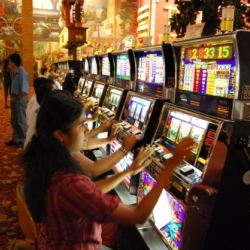Slot Machines Disappearing From Casino Floors

The gambling industry is rapidly changing in order to adapt to the ever evolving interest of consumers, which are expanding beyond the traditional casino gambling experience. As a result, US casinos are increasingly focusing on a variety of ways in which to provide more luxurious amenities and better appeal to those vacationers looking for a complete four or five-star getaway experience. If you want proof of that, you only need to look at what is happening on the casino floor, where slot machines numbers are being thinned out at a dramatic pace.
21% Reduction Since 2007
Recently, two analysts at Deutsche Bank conducted a survey of 12 of the largest casino companies in the U.S, which together, own 120 casinos in the United States, namely Ameristar Legacy Assets, Caesars Entertainment, Isle of Capri Legacy Assets, Eldorado Resorts, Pinnacle Entertainment, Boyd Gaming & Peninsula Assets, Las Vegas Sands, Mohegan Tribal Gaming, MGM International Resorts, Penn National Gaming/GLPI and Red Rock Resorts.
The analysts found that the number of slot machines in the properties that these operators own have been steadily declining since 2007. All in all, the casinos have eliminated 43,400 slot machines, marking a 21 percent decline in their numbers over the past decade, and commenting on the development analysts Carlo Santarelli and Danny Valoy stated:
“All 12 operators in our analysis have culled their floors. We believe this trend is likely to continue into the foreseeable future as operators shift financial resources to other amenities and continue to seek efficiency on floors.”
Appealing to Millennials
In the past, casinos sacrificed much of their floor space to pack in more slot machines, as at that time they were a major draw for the ideal gambling patron, and therefore provided the biggest bang for the operators’ buck. Today’s ideal customer is not as interested in slots, however, as millennials have proven to be more interested in enjoying other amenities offered at casinos, such as bars, restaurants and live entertainment. Consequently, it seems that casino operators are now looking to make more room for these non-gambling services.
Higher Markup
Casinos’ shifting focus on all-around entertainment does more than just potentially attract more millennials, though, especially as non-gaming sources of revenue offer more profitable margins for the individual casino operators. In fact, hotel rooms, dining and special events all have a higher markup compared to their costs than gambling activities, and by diverting funds and space to non-gaming activities and amenities, casinos can lower costs and increase profits. Already Las Vegas is poised to earn more revenue from its hotel rooms than it does from its gambling floor, with UNLV’s David Schwartz recently explaining:
“If the current trend continues, by 2019, rooms will make about as much money as the casino floor, in 2020 they will surpass it, and by 2023, Las Vegas Strip resorts will make about $2 billion more from their rooms than their gambling.”
Skill-Based Slots Innovations
Although it is clear that slot machines are becoming less abundant at many casinos, it’s not time to count the Old School form of gambling out just yet. Instead, many operators are looking to add new slot machines that combine a classic slots experience with an element of skill, as these hybrid gaming machines tend to appeal more to millennials.
In addition, the analysis found that the trend of reducing the number of slot machines seems to be confined to commercial casinos only. Tribal casinos, on the other hand, are actually adding slot machines to many properties. Perhaps this can be explained by casinos deciding to try and swoop up displaced gaming enthusiasts by offering more slots on their gaming floors. It makes sense for tribal casinos to take this approach, too, as most are located in regional areas rather than major metropolitan areas that tend to be vacation destinations.
Conclusion
Based on the numbers reported in the Deutsche Bank analysis, we can expect larger casinos to continue to focus more on entertainment with slot machine numbers continuing to decline over the years to come. Summing up the current trend, an article which appeared in the Press of Atlantic City recently explained:
“In 1989 non-gaming revenue represented 21 percent of total casino revenue; as of 2015, it represents 29 percent. For casino industry leader Las Vegas, the shift is even more distinct from a 60/40 split gaming vs. non-gaming in 1989 to a 35/65 split in 2015.”








